Notes
Stirring NFL Protest Optics: Unity to What End?
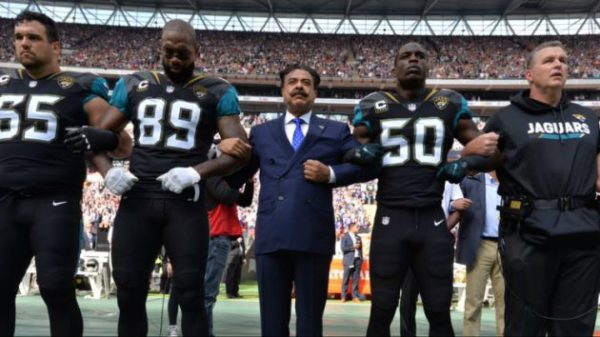
Week 3 of the 2017 National Football League (NFL) season will be one to remember. Last Friday, President Trump expressed his contempt for professional athletes who have used the national anthem as a platform to protest racial injustice. (See here, here, or here, for examples from just this season).
The president crudely derided the protestors, as he boasted, “Wouldn’t you love to see one of these NFL owners, when somebody disrespects our flag, to say, ‘Get that son of a bitch off the field right now, out, he’s fired.’” Trump’s vulgarity, however, should not distract from the main issue: his insistence that the national anthem compels patriotic compliance and individual silence.
Protests during the national anthem at sporting events are not new. (Besides Colin Kaepernick’s last season reviewed here yesterday, see 2003 or 1996, 1969, or the iconic protest by John Carlos and Tommie Smith at the 1968 Summer Olympics.) What is new about the NFL’s protests this past weekend, however, is the scope. Across the NFL (and elsewhere, including the WNBA Finals), athletes visibly and unapologetically expressed their displeasure with Trump’s remarks.
A review of yesterday’s photos is revealing. Labeling Trump’s comments as “divisive” (see here or here, for examples), players and several owners characterized their actions on Sunday as a display of “unity” (or “solidarity,” as evidenced by this ESPN clip). Indeed, mainstream media overwhelmingly featured the unity theme, pointing out that even owners such as Arthur Blank, Jerry Jones, and Shahid Khan (in the photo leading this post) chose to lock arms with players on the field during the performance of the anthem.
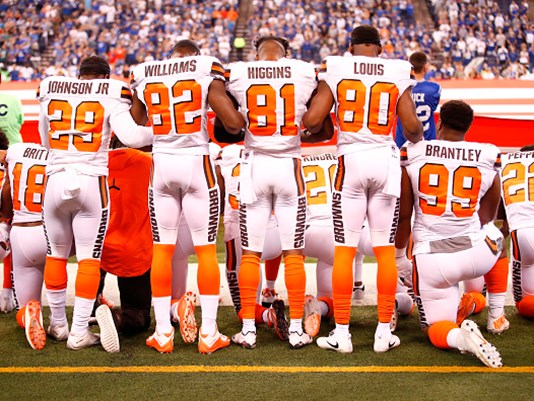
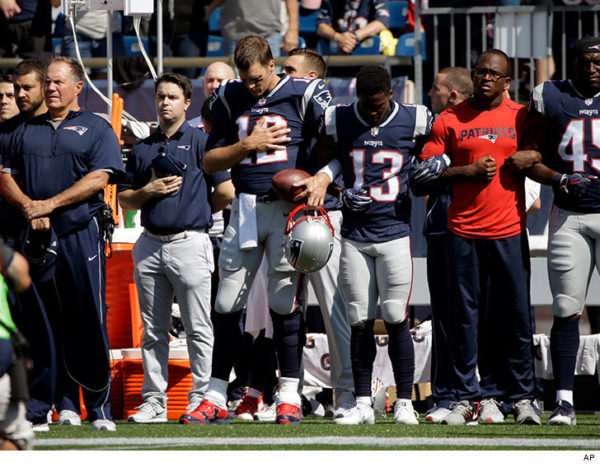
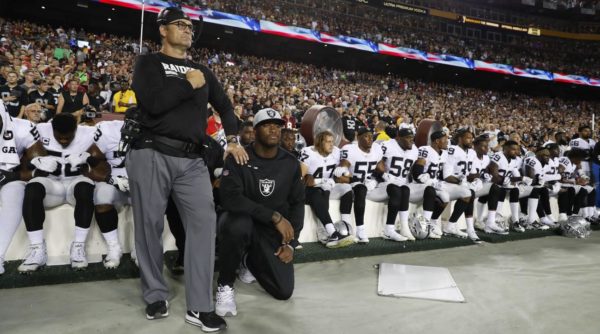
Without question, these images are powerful. They hail back not only to sports but the larger purpose of the Civil Rights Movement. It is no accident, for example, that players kneeling during the anthem have been compared favorably to Martin Luther King. To the extent that Sunday’s protests unify people in response to hatred and violence I celebrate them. But I also urge caution. This caution is less about what is present in these images than what is absent.
In short, “unity” is presented as an end in and of itself, as an inherent good that, in this case, is largely a response to Trump’s divisiveness. But “unity” is what the anthem ritual has always been about—it is expressly designed to unify the fans, to call different people together in the spectacle of competition. During national events like the Super Bowl, or the international Olympics, the anthem serves as a rallying cry. It declares, no matter your rooting interests: we are a “united” people. Historically, any break from that “unity”—whether from players, fans, or others—has been met with severe criticism and accusations of being un-American.
Such an accusation is precisely what Kaepernick faced last season and is inarguably the pretext for his exclusion from the NFL this season.
As much as I agree with Kaepernick and believe he has been ostracized from the league for it, social protest carries with it a degree of risk. In other words, ownerships’ refusal to sign him to an NFL contract highlights the very lack of unity purportedly symbolized by the anthem in the first place. Colin Kaepernick wanted the American people to contend with inequality and injustice, to acknowledge the patterns of violence inflicted upon people of color in this country, and to disrupt the illusion of unity that is condensed in patriotic symbols and rituals at sporting events.
As encouraging as the explosion of protest in the NFL may be, let us remain focused on the purpose of such protest in the first place. As Philadelphia Eagles safety Malcom Jenkins said:
It’s not about the protests. It’s not about the national anthem. It’s really about effecting change in our communities.
With that in mind, let our lingering image of Sunday not merely be of interlocking arms and “unity”; rather, let it be a raised fist of continued insistence that the status quo can no longer hold.
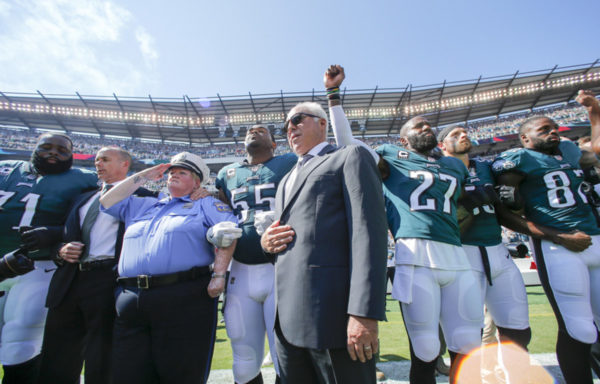
Photo: Jacksonville Jaguars via Twitter. Caption: Several NFL players took a knee or locked arms on Sunday during the National Anthem of the first game since President Donald Trump began his crusade against such protests. The game between the Baltimore Ravens and Jacksonville Jaguars took place Wembley Stadium in London. Among those who participated in the protest was Jaguars owner Shahid Kahn, who locked arms with tight end Mercedes Lewis and linebacker Telvin Smith. Photo 2: Andy Lyons/Getty Images Caption: Members of the Cleveland Browns stand and kneel during the national anthem before the game against the Indianapolis Colts at Lucas Oil Stadium on September 24, 2017 in Indianapolis, Indiana. Photo 3: Steven Senne/Associated Press Caption: Tom Brady locked arms with a teammate during the national anthem before the game against the Houston Texans on Sunday. Photo 4: Alex Brandon/ Associated Press Caption: Some members of the Oakland Raiders kneel during the playing of the national anthem before an NFL football game against the Washington Redskins in Landover, Maryland, Sunday, September 24, 2017. Photo 5: Yong Kim/ Philadelphia Inquirer Caption: Eagles owner Jeffrey Lurie stands with Eagles defensive end Brandon Graham and strong safety Malcolm Jenkins during the national anthem before Sunday’s game. September 24, 2017.
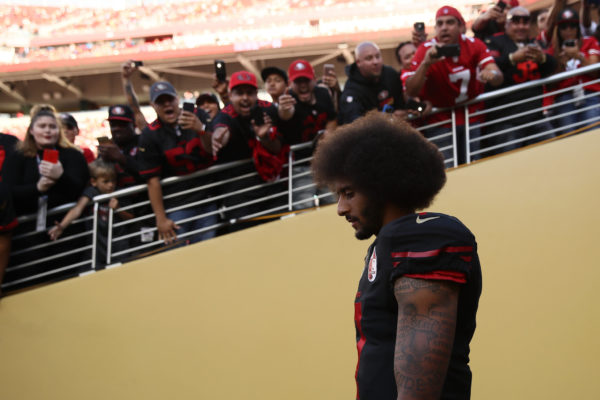

Reactions
Comments Powered by Disqus